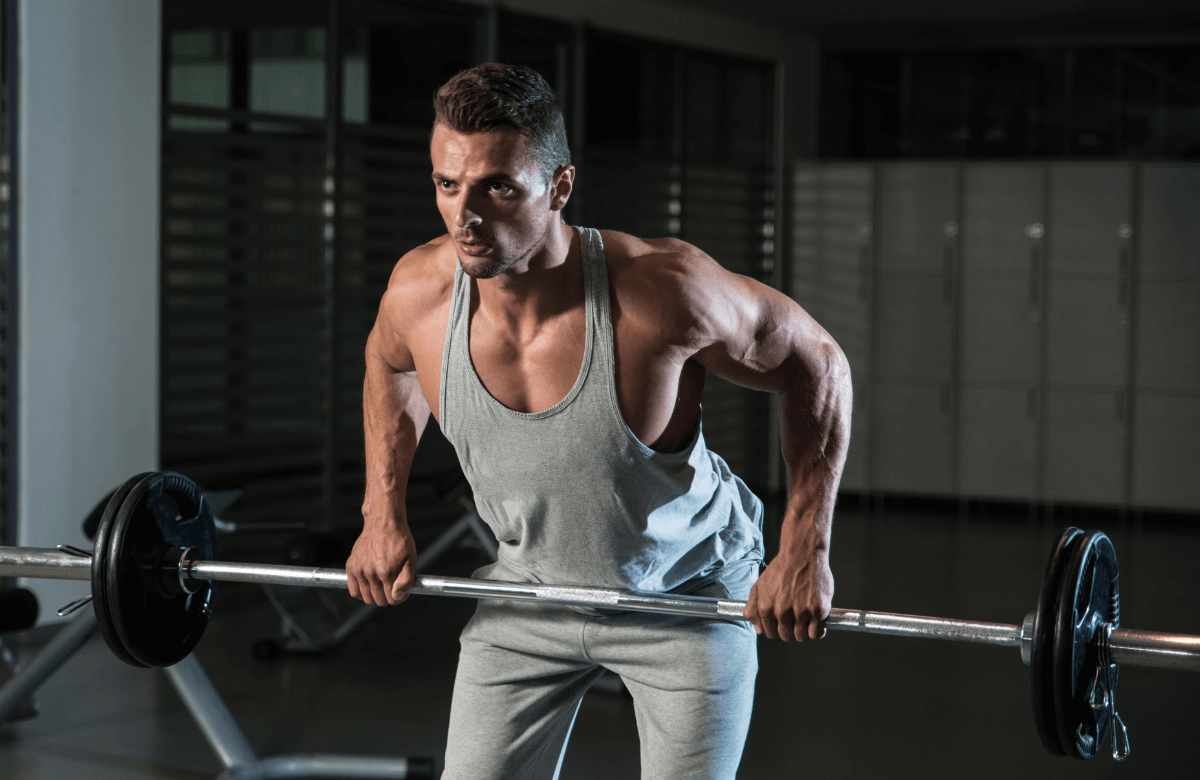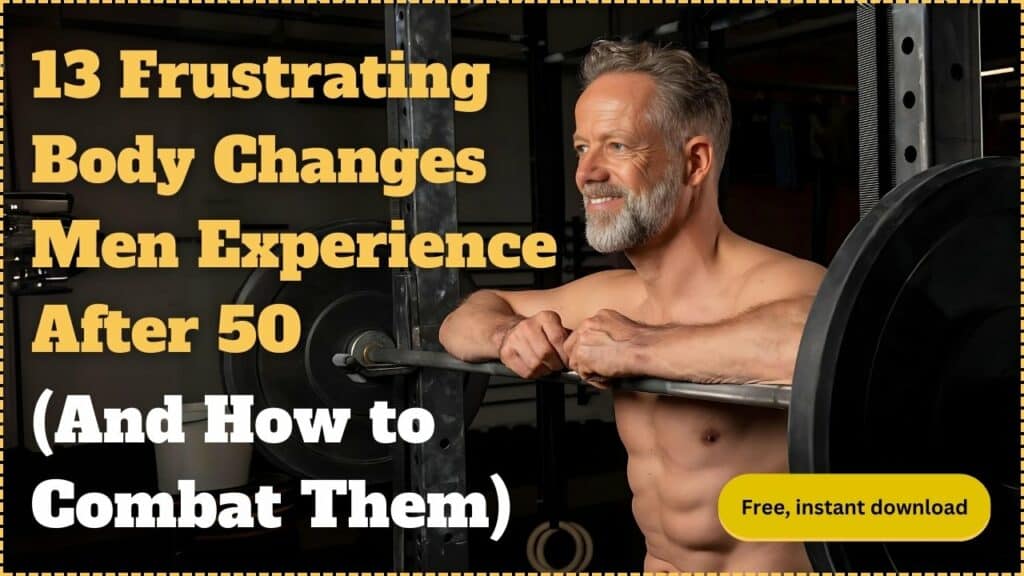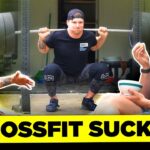Bent over row exercises are a core back day workout routine with tremendous results for the upper body. But knowing how to exercise correctly is crucial to reaping those hard-earned muscle-building benefits.
Continue reading to learn more about this popular exercise, how to do the bent-over row correctly, and some tips that will help make your workout more efficient and rewarding.
Jump to:
How to Do a Bent-Over Row
The bent-over row has three simple steps. Follow each precisely to quickly strengthen your back muscles without worrying about back strain or injury. Let’s begin.
Step 1: Stand over the barbell or dumbbells with hands and feet hip- or shoulder-width apart. You’ll use a double overhand grip when picking up the bar or dumbbells.
Step 2: Bend over until your torso is roughly parallel to the floor and your back is straight. Lift the weights to the starting position, about waist height. Drive your elbows behind your body while squeezing your shoulder blades.
Step 3: While maintaining close control of the weight and your movements, pull the barbell or dumbbells toward your body until they touch your naval. Then lower the weight back to the starting position.
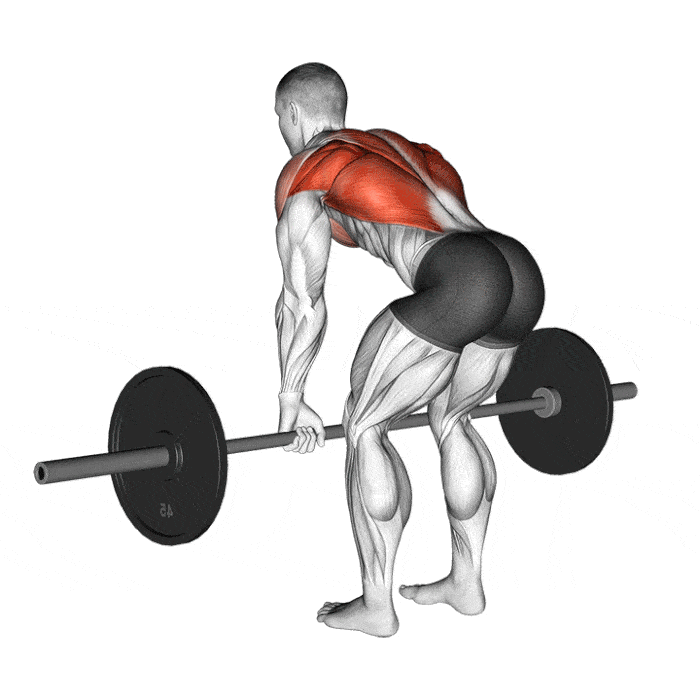
And that’s all it takes. The goal is to keep your core tight, your back straight, and your arms close to your sides as you perform the movement. Let your shoulders squeeze together as you pull to make sure you’re using the right muscles. Continue with these three steps through the desired amount of reps.
What Muscles Do Bent Over Rows Work?
The bent-over row is an excellent functional exercise for building back strength because it’s a compound body resistance exercise, meaning it works multiple muscles. These muscles include the rhomboids and trapezius, deltoids, biceps brachii, erector spinae, and transverse abdominis. Let’s learn more about each one and how bent-over rows help strengthen them.
Rhomboids and Trapezius
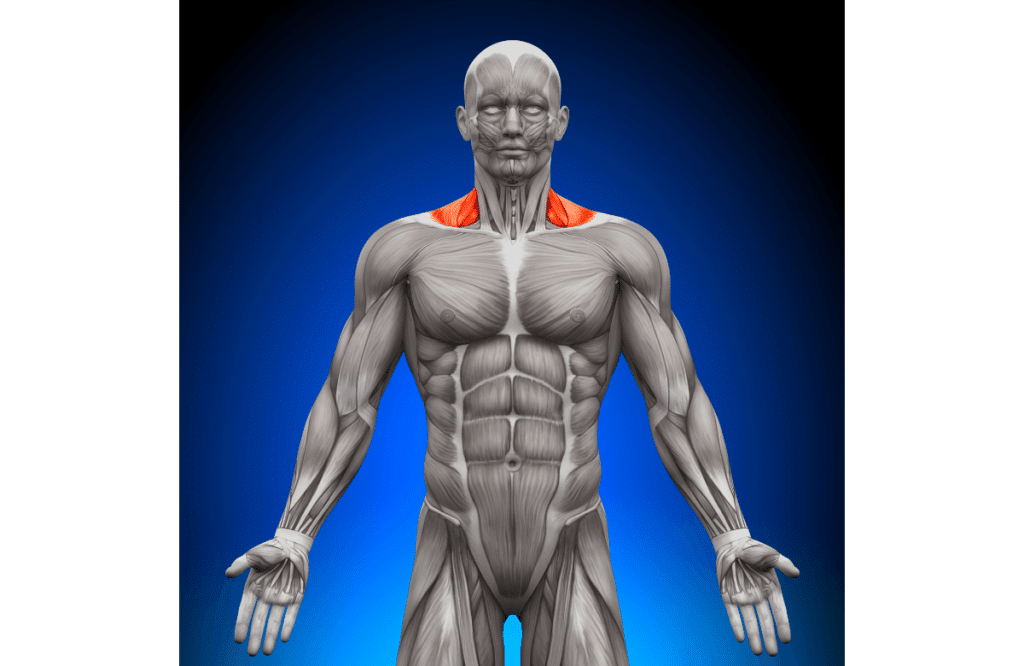
The rhomboids and trapezius are the middle back muscles. We use these muscles primarily to move the shoulder blades. Lifters doing bent-over rows strengthen these muscles by retracting their shoulder blades during the lifting portion of the exercise.
Deltoids

The deltoids are the muscles directly on your shoulder, right where your arm connects to your torso. The deltoids move your arms in different directions and help to stabilize the shoulder joint. The deltoids are activated during the bent-over row’s lifting and descending process. And some lifters suggest you can engage the deltoid more by abducting your shoulders more than with the standard form.
Biceps Brachii
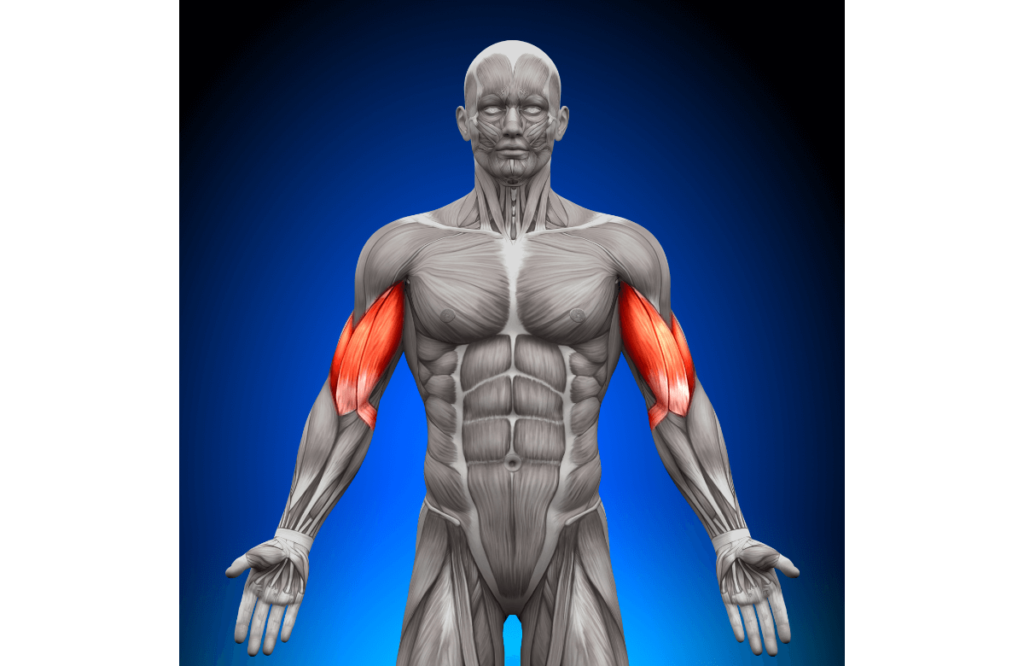
You can find the biceps brachii in the front of your upper arm. These muscles move the arm primarily by extending or retracting the arm at the elbow joint. You engage these muscles when you raise the barbell from the floor and complete the row movement.
Erector Spinae
The erector spinae comprise the intermediate muscles in your deep back on either side of your vertebral column or spine. These muscles run from the skull to the pelvis. During bent-over rows, the erector spinae helps the body bend and straighten the back. It also helps to maintain balance throughout the lift.
Transverse Abdominis
The transverse abdominis primarily protects internal organs and supports core stability in the spine and pelvis. This stability is critical for any stable movement to occur. Improving or strengthening this muscle group will help with a lifter’s overall strength and balanced physique.
Benefits of Bent-Over Rows
There are many exercise benefits or rewards of doing bent-over rows regularly. These rewards include greater bone density, improved core strength, increased muscle mass, and reduced lower back pain. Join us as we look at each benefit in more detail.
Greater Bone Density
Bent-over rows can help build greater bone density, preventing the onset of chronic bone diseases, such as osteoporosis. Exercises focusing on building muscle mass can also help prevent other muscular disorders.
The movement can also improve overall joint health and strength, which is good for balance and is especially beneficial for senior or elderly individuals.
Core Strength
Bent-over rows activate your core muscles, providing stability throughout the lift and maintaining balance. Therefore, bent-over rows effectively improve core strength, giving more significant spine and posture stability. And improved core strength can help lifters carryover from the bent-over row to deadlift exercises. So if deadlifts are your ultimate goal, bent-over rows are a great place to start.
Increased Muscle Mass
People have been using bent-over rows for decades because they’re so good at increasing muscle mass. Bent-over rows are an excellent compound exercise that allows athletes to lift more weight. This exercise symmetrically activates most lower and upper back muscles, preventing muscle imbalance and making it optimal for muscular hypertrophy or growth.
Reduced Low Back Pain
As stated before, bent-over rows can improve your core muscle strength which has excellent benefits. But improved core strength can also mean less back pain because one common reason for lower back pain is a weak core. Exercises that strengthen the core muscles can bring much relief.
But work slowly and consider talking to a doctor or strength coach before beginning bent-over rows if you have back pain. Overdoing reps or using heavier weights can lead to severe muscle strain or injury.
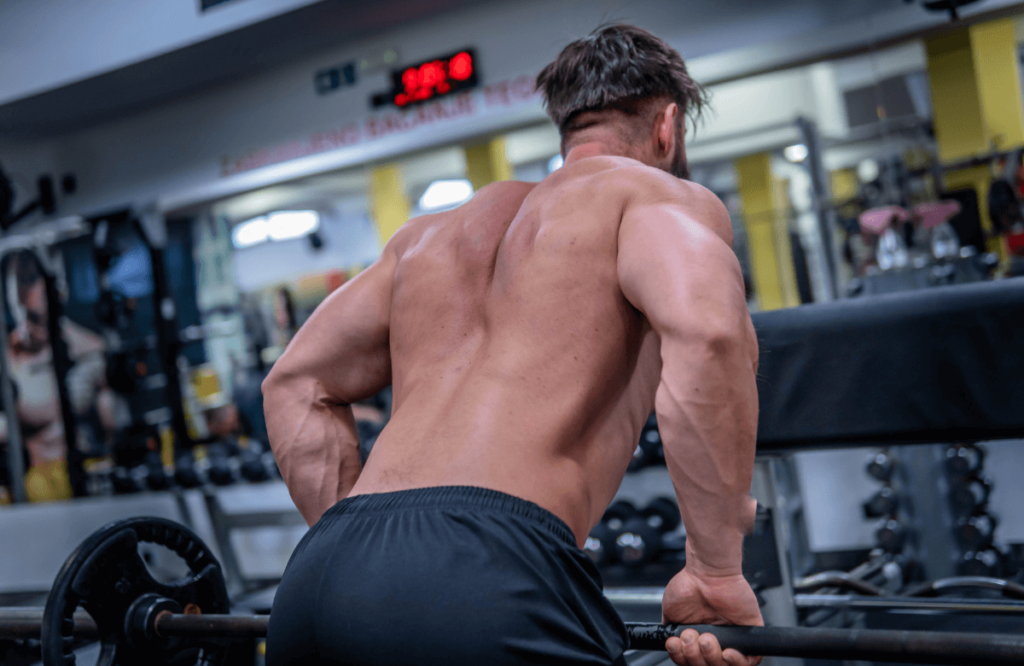
Common Mistakes
Although the proper form of a bent-over row seems simple, there are some common things that people need to correct. Some of these mistakes include bending too far or not enough, floppy or bent wrists, rounding the back or shoulders, shifting legs, or lifting heavy weights. Any of these mistakes will make the rows more difficult and could also lead to muscle strain or injury.
Bending Too Far or Not Bending at the Hips
When performing bent-over rows, lifters must lean over the barbell with their torso parallel to the floor. Bending too far or not enough can lead to muscle strain or injury.
Experts recommend bending over by thrusting your hips backward instead of simply bending or folding over because pushing your hips back maintains a spine-neutral position throughout the lift.
Floppy or Bent Wrists
Wrists should be straight with hands in a double overhand grip. A floppy or bent wrist causes increased bicep activation, reducing the activation of the back muscle groups. Ironically, activating your bicep during the bent-over row reduces the weight you can lift.
What’s worse, bending your wrists during the movement can cause excessive stress on the tendons and muscles in your wrist and forearm. You’re likely to develop a painful overuse injury over time in your wrist and forearm, even weakening rather than strengthening your wrist muscles. Without correction, floppy wrists during any exercise could cause chronic pain in this joint.
To avoid floppy wrists when doing bent-over rows, lifters should visualize everything from their elbow down as a stiff hook. Keeping wrists tight will prevent injury and help to activate your back muscles more during the lift and improve muscle growth in your back.
Rounding Your Back or Shoulders
Rounded back or shoulders occurs when you let your chest fall during the lift, leading to spine flexion or a rounded back and shoulders. Individuals who try to do bent-over rows with a rounded back or shoulders reduce the amount of weight they can lift and the overall effectiveness of this excellent exercise. It can also cause back pain or injury.
Additionally, a rounded back changes your center of gravity, which causes your hips to tilt forward. And as we stated earlier, the perfect form requires the hips to be pushed back with a neutral spine position throughout the lift.
Shifting Your Legs
Leg position and form are crucial for effective bent-over rows. Your legs must be shoulder-width apart and stationary throughout the lift. Shifting your feet or legs mid-lift could cause a fall or injury.
Also, although experts discourage excessively shifting your legs, you can’t have overly straight legs either. Bending at the knee lets you push your hips back into the neutral spine position. Straight legs cause spine flexion, leading to a lower back injury and reducing your overall weight limit.
Lifting Too Much Weight
There are very few things that pose as much risk of injury as lifting too much weight. It can be detrimental, if not dangerous. Too much weight on your barbell often leads to improper form and poor muscle growth and can cause serious back injury.
Therefore, when beginning bent-over rows, lift a weight that feels comfortable while mastering the correct form. Then you can slowly increase the overall weight.
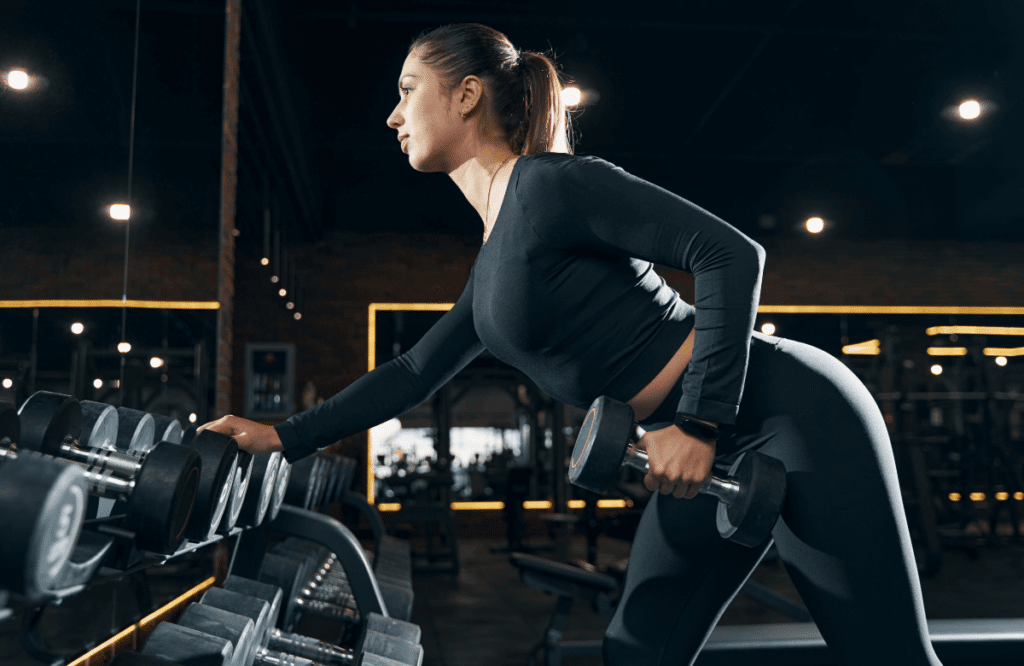
5 Tips for How to Do Bent Over Rows Properly
While we often see common mistakes involved with bent-over rows, all it takes is some simple tips to improve your form and increase the move’s benefits. Here are some simple tips that can help.
1. Focus on Your Elbow Placement and Movement
Elbow placement ensures you have proper form and that you’re activating your target muscles. Incorrect elbow placement could lead to your arms doing more work than you want, decreasing the amount of muscle mass obtained. Remember to try to envision your arms from your elbows down as a straight hook that can’t move. Thinking this way will help you engage more of your back muscles, which is what you want to see.
2. Pause at Full Extension
Always pause at the top of the lift where the barbell touches your stomach. Holding the barbell at full extension causes the scapula to retract, which increases muscle strength and mass.
Often, lifters cannot reach full extension because they’re either trying to lift too much weight or they’ve put too much emphasis on raising the barbell off the floor instead of focusing on the row portion of the lift. Reducing the weight on the barbell or ensuring your mind-muscle connection is correct can help you reach full extension.
3. Keep Your Core Tight
Keep your core tight throughout the whole row. Tight abdominals stabilize the lift and provide balance while exercising. Keeping a tight core also helps prevent injuries, and improving your core muscle strength can reduce back pain because lower back pain is often caused or exacerbated by weak abdominals.
4. Breathe Through the Exercise
Don’t forget to breathe. This one seems so simple, but it’s surprising how many people fail to inhale in the middle of their lift. Always inhale as you ascend and exhale as you descend.
When lifters fail to breathe through the entire exercise, it leads to muscle tension. Tense muscles cannot perform at 100% and time under tension can easily lead to muscle strain or injury. Breathing throughout the whole lift keeps stress low and muscles loose.
5. Do the Correct Number of Sets and Reps
Don’t overdo it. Ensure you have the correct weight and number of sets and reps. Too few will be ineffective and won’t yield results. But overdoing it with too many sets or reps can lead to muscle fatigue, strain, or injury.
The number of sets and reps you should do depends on the exercise, the amount of weight, and your goals. Most lifters will do 3-4 sets of 10-15 rows per session. However, you should curate your own sets and reps based on your goals.
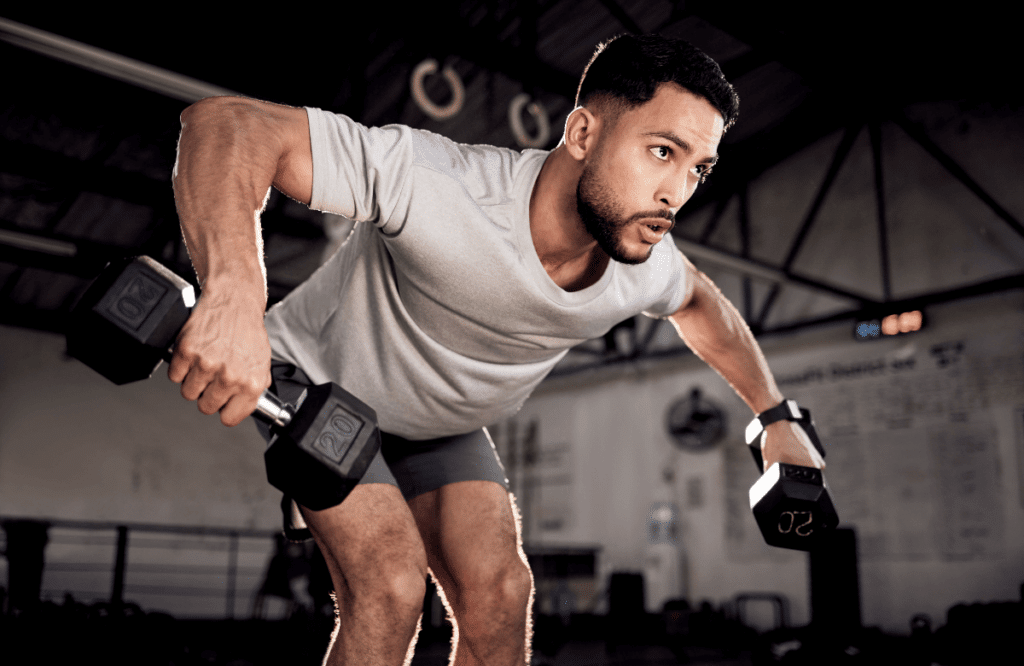
FAQs About How to Do Bent Over Rows
Hopefully, you’ve learned a lot about bent-over rows. Hopefully, we’ve answered most of your questions with the above information, but if not, here are some frequently asked questions. Read through to learn just a few more things about bent-over rows.
Are Bent Over Rows with Dumbbells and Barbells the Same?
Arm dumbbell rows and barbell rows are very similar because they use identical form and movement. But the difference in equipment yields some differences. The obvious difference is the use of dumbbells vs barbells, making dumbbell rows more accessible than barbells. Most people don’t have barbells at home, but almost everyone owns a pair of hand weights.
When it comes to getting results, barbell rows may be more effective. You can use heavier weights doing a bent-over row with a barbell than when doing a bent-over dumbbell row exercise. The joint arm strength used with barbells means you can lift more and develop those muscles faster.
Should Bent Over Rows Be a 45 or 90-Degree Bend?
Bent-over rows should be at a 45-degree angle, which is achieved by pushing your hips backward and leaning slightly over the bar. A 90-degree bend is too extreme and changes the lifter’s center of gravity and balance, which can cause muscle strain or injury.
The risk of injury to your back is most acute when you bend over too far. It’s difficult for your back to not engage at that angle. Plus, most people can’t bend properly at 90 degrees, which also increases the risk of injury.
How Much Weight Should I Be Able to Row?
The amount of weight you should be able to row depends on a few factors, including your experience, form, and current weight limit. Starting with too high a weight limit or making large jumps in weight can lead to muscle strain or injury.
Overall, expert advice suggests the average male lifter, at an intermediate level, can do about 180 lbs with a bent-over row. Beginner male lifters should aim for about 90 lbs, but you may want to discuss weight limits with your doctor or athletic trainer.



